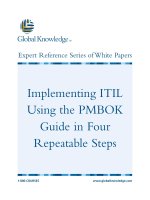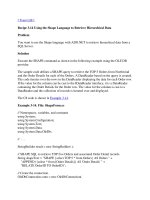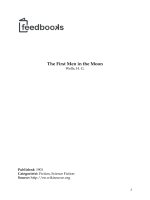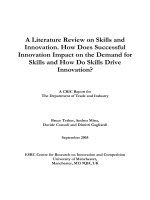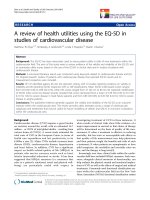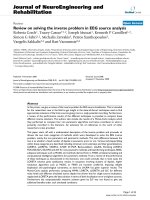A literature review on using the first language in a second or foreign language classroom
Bạn đang xem bản rút gọn của tài liệu. Xem và tải ngay bản đầy đủ của tài liệu tại đây (339.68 KB, 10 trang )
Journal of Science Ho Chi Minh City Open University – No. 3(15) 2015 – August/2015
95
A LITERATURE REVIEW ON USING THE FIRST LANGUAGE
IN A SECOND OR FOREIGN LANGUAGE CLASSROOM
Trinh Thai Van Phuc
Ho Chi Minh City Open University
Email:
(Received: 06 /06 /2015; Revised: 23/07 /2015; Accepted: 14 /08 /2015)
ABSTRACT
The paper seeks to review on the use of a first language or a mother tongue (L1) in a
second or foreign language (L2) classroom. The report examines permissible frequencies,
practical purposes and influential factors of the L1 employment in the L2 classrooms. The
findings provide that (i) there are mixed results of L1 use among novice and experienced
teachers or low-level and high-level students and among different language teaching approaches
followed by (ii) three main categorized reasons facilitating the role of L1. The review further
suggests strong factors influencing the use of L1, namely task types, proficiency levels, teaching
experience, timetabling, pedagogical tools, learning strategies, teachers’ beliefs and learners’
perceptions. The review closes with conclusion and classroom implications.
Keywords: first language (L1), second/ foreign language (L2), the use of L1.
1. Introduction
Employing the first language (L1) in a
second language (L2) classroom has recently
sparked off considerable debate (Klapper,
2006) and proposed opposing positions
(White & Storch, 2012) in L2 language
learning and teaching. On the one hand, the
L2 learning is actively facilitated by the use of
L1 (Levine, 2003; Jingxia, 2010) and (2) L2
teaching-and-learning process is positively
influenced (Iqbal, 2011). Additionally, (3)
students’ communication problems can be
handled significantly by employing the L1 in
a L2 classroom (Moghadam, Samad, &
Shahraki, 2012; Jamshidi & Navehebrahim,
2013). Besides, Cenoz & Gorter (2011) assert
that students’ sense of identiy can be strongly
fostered by utilizing the mother tongue since
the native language is inevitably the
“language of thought” (Macaro, 2005, p. 68).
Indeed, the dominated viewpoints of anti-L1
attitudes for several decades have been
challenged by recent attention to the role of
L1 and of normal process of multilingual
functioning (Scott & Fuente, 2008).
Generally, the use of L1 is advocated in light
of some facilitative roles in the process of the
second language learning and teaching and of
inevitable occurrence among the language
teachers who share the same L1 with the
learners.
On the other hand, (i) L1 interferences
should be avoided in an L2 classroom by
advocating a policy of the only-and-sole target
language use so that a pure target language
exposure can be available to learners
(Lightbown, 2001; Chaudron, 1988; Ellis,
1984). In the same vein, Lee (2013) and
MacDonald (1993) echoes that (ii) students’
deprivation to opportunities of receiving and
producing the target language can be caused
by not supporting the only L2 policy.
96
A Literature Review On Using The First LanguageIn A Second Or Foreign...
Additionally, Nation (2003) cautions that (iii)
students’ motivation can be reduced if
overusing the L1, and L2 should be
maximized as much as possible in a
classroom. Furthermore, Ellis (2008) warns
that (iv) the overuse of the L1 should be
admonished because students have a
classroom context as their only place to be
immersed in the L2. In general, the L2-only
policy has strongly been promoted on account
of the valuable opportunities of pure L2
exposure
and
students’
motivation
enhancement.
Currently, English is regarded as an
official foreign language in Vietnam and is
supposed to be fully used and instructed in all
EFL classrooms although none of official
documents are released to regulate the
frequency of Vietnamese use in the EFL
classrooms. As a consequence, the rationale of
employing L1 in EFL classrooms mainly
relies on teachers’ beliefs and practices.
Personally, as a teacher of English language, I
sometimes feel guilty that the use of
Vietnamese (L1) makes students lack of the
English language (L2) exposure. Even more,
they seem to undervalue the opportunities of
using the L2 when required because of the
habit of overusing the L1. For some other
times, the use of L1 can save my times of
instructions for other classroom activities
because of our few weekly classroom
meetings. Besides, while L2-only policy is
given in my classroom, it gives my students a
burden on communicating and intermingling
in complex activities and understanding
clearly what they are required to do. This
investigation practically sheds light on my
understanding about some advantages and
disadvantages of using the L1 in my EFL
classrooms.
The
paper
consequently
and
subsequently seeks to review on the
frequencies, purposes, and influential factors
for employing the L1 in an L2 classroom. In
doing so, the review begins with the
frequencies of L1 utilization in which mixed
findings and different approaches with
different L1 use frequencies are mainly
presented. Next, the three main categories of
purposes of L1 utilization are illustrated
before influential factors including teachers
and learners’ beliefs are provided. The
reasons for monolingual approach advocating
the L2-only policy will be reported then. The
review closes with classroom implications and
conclusion.
2. Literature Review
Frequencies of L1 Use
The findings from various studies
related to the frequency of L1 use are quite
mixed. For instance, Macaro (2001) and
Guthrie (1987) show a low level (under 20 per
cent) of teachers’ first language use during
class time while Edstrom (2006), Kim &
Elder (2005), Rolin-Ianziti & Brownlie (2002)
and Duff & Polio (1990) highlight great
variations among teachers’ use of the first
language (from 10 to 100 per cent).
Additionally, Crawford (2004)’s study shows
that teachers’ L1 use gradually decreases from
low level of L2 competence to intermediateor-upper levels. In other words, the utilization
of L1 by the teachers in beginner-level classes
is higher than that of L1 use in intermediateor-upper-level classes. In the same vein,
experienced teachers report a lesser
proportion of L1 use in comparison with
novice teachers do (Kraemer, 2006).
Generally, Campa & Nassaji (2009) reveal the
frequency use of L1 varies among teaching
contexts while White & Storch (2012) explain
different analysis methods of teacher talk
(e.g., word count, turn count, or both)
significantly lead to mixed findings.
Regarding the L1 use by students in a
classroom, in a study of Yan, Fung, Liu, &
Huang (2015) investigating the context of
target English language (L2) use of Chinese
students, the results show that the frequency
Journal of Science Ho Chi Minh City Open University – No. 3(15) 2015 – August/2015
of students’ L1 use significantly increases
from junior high school students to senior
ones because there are more emphasis on
preparing students for national university
entrance examination. However, in another
study examining frequency of L1 use in
students’ interaction by Swain & Lapkin
(2000), the higher L1-use frequency of lower
proficiency students is reported. In contrast to
Swain & Lapkin (2000), Storch & Aldosari
(2010) investigate the L1 utilization by 15
pairs of college students with different
combinations of proficiency levels. A finding
shows a low frequency of L1 use (under 20
per cent) in which the L1 frequency use is not
influenced by proficiency levels but by
students’ beliefs for an opportunity for the
practice of the target language.
Besides, different approaches of
language teaching and learning cause different
frequency of L1 use (Richards & Rodgers,
2001). According to Richards & Rodgers
(2001), some approaches fully promote the
use of L1 while others partially allow or
completely forbid the L1 utilization.
Regarding the full allowance of L1
employment, Grammar-Translation Method
(GTM) comes first on the list. More
specifically, GMT fully approves the use of
L1 in which reading literacy through
translation exercises and deductive grammar
rules are focused. Second, Community
Language Learning (CLL) is another one
promoting the full employment of the L1.
CLL strongly relies on the language
interpretive equivalents between the two
languages. Students learn the L2 through a
flow of L2 messages and its parallel meaning
of a flow of L1 messages.
In contrast, Natural Approach (NA),
Total Physical Response (TPR), Direct
Method (DM), and Audiolingualism (ALM)
ban the use of L1 in the classroom outright.
These approaches confirm that (1) the target
language should be instructed and used
97
exclusively in the classroom and (2) overt L1
use for grammatical instruction should be
deemphasized.
Besides, some other approaches
partially allow the use of L1 such as
Communicative Language Teaching (CLT),
Content Based Instruction (CBI), Cooperative
Learning (CL), Task Based Language
Teaching (TBLT), Suggestopedia, etc. These
approaches take a neutral/ or no stance on
employing the L1 in an L2 classroom. The use
of L1 is flexible and various among the
teachers. Generally, the facilitative role of L1
is regarded differently in different approaches
and based on different situations and purposes
of teaching (Larsen-Freeman, 2000).
In brief, the use of L1 varies among
novice and experienced teachers or low-level
and upper-level students and differentiates
among teaching approaches. Different
frequency rates of the L1 use suggest that the
use of L1 relies on different classroom
contexts and circumstances.
Purposes of L1 Use
Regardless of mixed findings from a
permissible frequency of L1 use, reasons
utilizing the first language are mainly
presented in three categories, namely,
cognitive, pedagogical and affective reasons.
For cognitive reasons, language learners
inevitably relate a plethora of information
about their first language (such as syntax,
lexical sources, etc.) to learn a second
language (Rell, 2005). Consequently, the
utilization of the mother tongue significantly
enables their available asset to promote the L2
learning process. Macaro (2009) and Ellis
(2005) backs up Rell (2005)’s notion that
there is a connection between the L1 and the
L2 conceptual stores. Both the two resources
of lexical items are activated when a language
is processed. Particularly, for non-balanced
bilinguals, such as a beginner language
learner, the connections with the first
language is much stronger to the ones of the
98
A Literature Review On Using The First LanguageIn A Second Or Foreign...
second language; as a consequence, it would
be an ignorance if avoiding the use of the L1
during the second language learning process.
For the pedagogical issues, the
allowance of the first language use serves a
humanistic function (Atkinson, 1987; Rell,
2005) when it acknowledges the learning as
truly for adults with live experiences instead
of child-like mimicking and guessing meaning
from puppets and stuffed animals. In addition,
the L1 use can make instruction clearer for
students to complete the tasks and exercises
successfully (Chambers, 1992). Moreover,
using the L1 significantly save time for other
activities and practices in the classroom
(Tang, 2000). Furthermore, promoting the use
of the L1 essentially increase students’
participation in the classroom (James &
Bourke, 1996). Besides, Polio & Duff (1994)
provided five categories of L1 utilization
consisting of grammar instruction, classroom
management, administrative vocabulary,
solidarity reflection, and teachers’ English
practice among which the most practical and
pedagogical purpose of using L1 reported is
related to vocabulary, particularly for
vocabulary translation (Rolin-Ianziti &
Brownlie,
2002)
and
administrative
vocabulary (Kraemer, 2006).
For the affective themes, Polio & Duff
(1994) asserts that the teachers resort to use
the L1 to strengthen relationship with
students, to build rapport and to play a role as
an “empathetic peer” (p. 318) since the close
relationship between the teachers and the
students helps to improve the students’
learning. Besides, an opportunity to use the
native language in a second/ foreign language
classroom helps to reduce students’ anxiety
(Casado & Dereshiwsky, 2001), to increase
students’ confidence (Campbell, 1997), and to
fit students’ learning preferences (Schweers,
1999).
Generally, the reasons of using L1 are
categorized into three intentional themes. L1
use firstly helps learners’ available cognition
assets facilitating their L2 learning. The
employment of L1 in an L2 classroom
secondly is beneficial for pedagogical
practices of language teachers. Finally, the
utilization of L1 plays an affective role to
establish a good and personal rapport among
teachers and students, which helps to motivate
students’ learning, reduce their anxiety, and so
on. Indeed, these purposes are seemingly in
accordance with Macaro (2009)’s three main
underlying theories supporting the facilitative
role of L1, namely cognitive processing
theory, sociocultural theory and codeswitching in the naturalistic environments.
Factors affecting the employment of L1
Beside
the
areas
of
research
investigating purpose and frequency use of
L1, there is another area of research
examining influential factors for the use of
L1. In a study by Duff & Polio (1990)
observing thirteen teachers in two classes, a
number of possible factors are listed, namely
exercise types, department policy, and teacher
training nature. Indeed, exercise-type is found
as an influential factor for the teachers’
utilization of L1 by subsequent studies of
Rolin-Ianziti & Brownlie (2002) and Kim &
Elder (2005) in which grammatical exercises
employ more L1 than task-based ones. In the
same vein, Scott & Fuente (2008) conduct
two conversation analysis studies focusing on
grammatical-form tasks of two groups (06
pairs) of French and Spanish foreign language
students in which L1 is allowed for one group
(03 dyads) and L2 only is employed for the
other group (the other 3 dyads). The results
reveal that the group employing only L2 have
a burden to produce and process
metalinguistic talk while the group approving
the use of L1 have more learners’
participation. This highlights the correlation
between grammatical tasks and the use of L1
in the study. In another study by Nakatsukasa
& Loewen (2015) examining the teachers’ use
Journal of Science Ho Chi Minh City Open University – No. 3(15) 2015 – August/2015
of English (L1) in a Spanish (L2) classroom
during form-focused episodes (FFEs) at a
university in the USA. The results similarly
show that L1 used mostly in form-focused
activities. In brief, task types such as
grammatical tasks and activities mainly lead
to the use of L1.
In a larger sampling investigation by
Crawford (2004) investigating the views on
the use of target language of 581 high school
teachers, the results show that the use of L1 is
higher in low-level classes than in upper level
classes. The findings suggest students’
proficiency level is a signal of another
influential factor for the use of L1. Besides,
Kraemer (2006) reveals that teaching
experience is regarded as the factor as well
because novice teachers employ more L1 than
experienced ones. Other influential factors for
the L1 employment of teachers are found such
as classroom organization and management
(Grim, 2010) and schedule of class meetings
(White & Storch, 2012). Teachers with less
weekly class meetings tend to use L1 as a
pedagogical tool to save times for other class
activities.
In addition to factors of task types,
proficiency levels, teaching experience,
timetabling, and pedagogical tools, teachers’
beliefs and learners’ perceptions are strongly
indicative factors for the use of L1. In a study
by Storch & Aldosari (2010), students’ beliefs
about the valuable opportunities of L2
practice in the classroom leads to the low
frequency of L1 use. However, students in the
NSW Adult Migrant English Service,
Australia are reported by Chau (2007) that
they use L1 as a learning strategy to
communicate, give feedbacks and construct
utterances of the L2 within the L1 shared
groups. This metalinguistic function of L1
support can be found in another study of Scott
& Fuente (2008).
Regarding the teachers’ beliefs of
employing the L1, Anh (2010) investigates
99
attitudes of 12 Vietnamese EFL teachers at
three different universities in Ho Chi Minh
city, Vietnam. The results show that teachers
advocate a various but limited use of
Vietnamese in different contexts. Another
longitudinal study by White & Storch (2012)
investigating the use of L1 by a non-native
teacher and a native one teaching French to
intermediate students at two Australian
universities show that the status of nativespeaking is not a predictor for the teachers’
use of L1. However, the use of L1 mainly
relies on the teachers’ belief and goals in their
personal teaching contexts. A similar result
found by Mcmillan & Turnbull (2009)’s study
examining two teachers’ beliefs in the use of
English (L1) into French immersion classes
(L2) in Canada in which there are two
participants, a native speaker of French and a
non-native one. The findings show that L1 use
is influenced by the teachers’ beliefs. More
specifically, the native teacher prefers to use
L1 because his beliefs (i) are influenced by
growing up in a bilingual community; and, the
native teacher (ii) cannot tolerate students’
large ambiguity degree. In contrast, the nonnative teacher admonishes the use of L1 since
he is (i’) affected by his university lecturers
during the immersion program of French and
(ii’) patient for challenges of first few months
in the immersion. Generally, there are
contradictory and complex perceptions of
teachers and learners on the issue.
Moore (2013) conducts a both
quantitative and qualitative investigation into
the context of the L1 use during students’ peer
interaction at a Japanese university in Japan.
The results show that not only do individual
factors (e.g, proficiency levels, individual
preferences) influence the use of L1, but other
situational factors (such as focus of the talk)
strongly affect the L1 employment. In short,
both individual and contextual factors have a
strong impact on the employment of L1.
On the whole, task types (such as
100
A Literature Review On Using The First LanguageIn A Second Or Foreign...
grammar or form focused activities),
proficiency level (i.e., low-level students),
teaching experience (such as novice teachers),
classroom
management,
few
meeting
schedules, teachers’ beliefs, students’
perceptions, learning strategies of the sharedL1 group and contextual factors lead to the
utilization of the L1.
Reasons for the monolingual approach
Different from those advocating the L1
employment in an L2 classroom or the
bilingual approaches, ones supporting the
monolingual approaches or the L2-only in an
L2 classroom provide some following
reasons. First, Cook (2001) as cited in Anh
(2010) assert that the process of L2 learning is
similar to the one of L1 learning;
consequently, exposure to the L2 as much as
possible becomes of paramount importance in
the L2 learning. As a result, L2 should be
used solely in the classroom so that (i)
students can be exposed purely to the target
language (Ellis, 1984; Chaudron, 1988;
Lightbown, 2001) and (ii) students will not
miss an opportunity to be exposed to the only
classroom context of L2 exposure (Lee, 2013;
Ellis, 2008; MacDonald, 1993). Second,
depending on the use of L1 makes students
get used to the L1 use which negatively
affects their appreciation of the value of target
exposure they are exposed to (Bouangeune,
2009). Third, Sharma (2006) confirms that
students will learn to internalize, to think and
to use the L2 if they are exposed much to the
L2 input. Forth, Nation (2003) warns that
overusing the L1 probably demotivates
students to use the L2. Fifth, the use of L1 can
have a negative transfer to the second
language learning (Anh, 2010; Osswald,
2010). Sixth, the use of L1 can challenge the
teachers’ viability of their teaching methods
and their responsibilities to improve students’
target language (Carless, 2008). Another
reason disapproving the L1 use is that the L1
is often used inconsistently and randomly
(Bruhlmann, 2012). One more important
feature advocating the monolingual approach
is the importance of having native L2
speakers in L2 classroom since they are ‘the
best embodiment of the target and norm for
learners’ (Phillipson, 1992, p. 194 as cited in
Anh, 2010). This philosophy has deeply
influenced the mindset of a large numbers of
learners, policy makers, parents, and training
institutions (Osswald, 2010). In fact, having
opportunities to learn with native speakers of
the target language can help learners’
language learning experience considerably. In
brief, L2-only policy has its own advantages
in language learning process and positively
influences mindsets of a great number of
language learners, policy makers, and
language centers/ institutions.
Personally and currently, it is seemingly
inevitable for the employment of the L1 in my
L2 classroom with a frequency rate from ten
to twenty per cent probably because we share
the same L1. Among the categorized reasons,
the purpose of my L1 utilization mainly for
pedagogical and affective issues in which
classroom management, abstract word
translation, and close rapport mainly cause the
use of my Vietnamese. Besides, it seems to
me that my L1 employment depends on task
types and the students’ level of proficiency in
which grammar and low-level proficiency
students lead to my decision of using the L1
to save time for other activities, to clear up
misunderstandings and to avoid ambiguity in
the classroom.
In addition to the employment of the L1
by the teacher, from my observation, the use
of Vietnamese by students definitely occurs as
a learning strategy and a cognitive tool during
the speaking task in which background
knowledge and topic ideas are activated,
discussed and negotiated before they present
to their classmates even when the L1 use is
being banned outright. In writing tasks, it is
probable that the students utilize the L1 to
Journal of Science Ho Chi Minh City Open University – No. 3(15) 2015 – August/2015
brainstorm their ideas before actual writing as
well. It is probably presumable that the only
reason for their Vietnamese use in an English
classroom is that they take the available assets
of the share-L1 community for granted. This
review has significantly shed brighter light on
my personal issues and provided me with the
following concluding remarks.
3. Concluding remarks
Like two sides of a coin, using the L1 in
the L2 classroom has its advantages and
disadvantages
as
well
as
contains
contradictions and complexities (Copland &
Neokleous, 2011). A review has shown a
mixed finding in the frequency of the L1 use
and suggested considerable variations of the
L1 frequency differently used among the
classroom contexts and circumstances.
However, the use of L1 should be carefully
and consistently employed so that it is
positively beneficial for the L2 learning.
Another important implication from the
purposes of L1 use is that it is used
productively for cognitive enhancement,
pedagogical tools and close rapport
establishment among teachers and students.
101
Consequently, L1 should not be prohibited
outright; but it should be consciously used
with understanding and based on pedagogical
decisions. Indeed, there are two beneficial
pedagogical strategies encouraging the
production of target language presented by
Carless (2008), namely language monitor and
incentives.
Since there have been contradictory
perceptions and beliefs on the L1 use among
teachers and students, there is a necessity of a
clearer institutional policy on the inclusive use
of L1. By doing this, teachers are seemingly
able to measure their perceptions of L1
inclusion compared with the institutional
policy, to eliminate their ambiguity as well as
to increase their efficacy. Furthermore, the
emergent use of L1 occurring inevitably in a
L2 classroom helps instructors, policy makers
and language learners develop an awareness
of natural occurrence of L1 in a classroom
context (Moore, 2013). As a result, a method
possibly optimizing the benefit of L1 and
providing a framework of appropriate time of
L1 use in the L2 classroom should be
presented (Samar & Moradkhani, 2014).
REFERENCES
Anh, K. H. (2010). Use of Vietnamese in English language teaching in Vietnam: attitudes of
Vietnamese university teachers. English Language Teaching, 3(2), 119-128.
Atkinson, D. (1987). The mother tongue in the classroom: A neglected resource. ELT Journal,
41(4), 241-247.
Bouangeune, S. (2009). Using L1 in teaching vocabulary to low English proficiency level
students: a case study at the university of Laos. English Language Teaching, 2(3), 186193.
Bruhlmann, A. (2012). Does the L1 have a role in the foreign language classroom? A review of
the literature. Working Papers in TESOL & Applied Linguistics, 12(2), 55-80.
Campa, J. C., & Nassaji, H. (2009). The amount, purpose, and reasons for using L1 in L2
classrooms. Foreign Language Annals, 42(4), 742–759.
Campbell, I. (1997). Using English to support second language learning. Babel, 32(2), 10-14.
102
A Literature Review On Using The First LanguageIn A Second Or Foreign...
Carless, D. (2008). Student use of the mother tongue in the task-based classroom. ELT Journal,
62(4), 331-338.
Casado, M., & Dereshiwsky, M. (2001). Foreign language anxiety of university students.
College Student Journal, 35(4), 539-551.
Cenoz, J., & Gorter, D. (2011). Focus on multilingualism: a study of trilingual writing. The
Modern Language Journal, 95(3), 356-369.
Chambers, G. (1992). Teaching in the target language. Language Learning Journal, 6(1), 66-67.
Chau, E. (2007). Learners' use of their first language in ESL classroom interactions. TESOL in
Context, 16(2), 11-18.
Chaudron, C. (1988). Second language classrooms: Research on teaching and learning.
Cambridge: CUP.
Copland, F., & Neokleous, G. (2011). L1 to teach L2: complexities and contradictions. ELT
Journal, 65(3), 270-280.
Crawford, J. (2004). Language choices in the foreign language classroom: target language or the
learners’ first language? Regional Language Centre Journal, 35(1), 5–20.
Duff, P., & Polio, C. (1990). How much foreign language is there in the foreign language
classroom? The Modern Language Journal, 74(2), 154–166.
Edstrom, A. (2006). L1 use in the L2 classroom: One teacher’s self-evaluation. Canadian
Modern Language Review, 63, 275–292.
Ellis, N. (2005). At the interface: Dynamic interactions of explicit and implicit language
knowledge. Studies in Second Language Acquisition, 27, 305-352.
Ellis, R. (1984). Classroom second language development: A study of classroom interaction and
language acquisition. Oxford: Pergamon.
Ellis, R. (2008). The study of second language acquisition. Oxford: OUP.
Grim, F. (2010). L1 in the L2 classroom at the secondary and college levels: a comparison of
functions and use by teachers. Electronic Journal of Foreign Language Teaching, 7(2),
193–209.
Guthrie, E. M. (1987). Six cases inclassroom communication: A study of teacher discourse in the
foreign language classroom. In J. Lantolf, & A. Labarca (Eds.), Research in Second
Language Learning: Focus on the Classroom. NJ: Ablex.
Iqbal, L. (2011). Linguistic feature of code-switching: a study of Urdu/English bilingual teachers'
classroom interactions. International Journal of Humanities and Social Science, 1(14),
188-194.
James, C., & Bourke, J. (1996). Mother tongue use in bilingual/bidialectal educaction:
Implications for Bruneian Dwibahasa. Journal o f Multilingual and Multicultural, 17(2-4),
248-261.
Jamshidi, A., & Navehebrahim, M. (2013). Learners use of code switching in the English as a
foreign language classroom. Australian Journal of Basic and Applied Sciences, 7(1), 186-190.
Journal of Science Ho Chi Minh City Open University – No. 3(15) 2015 – August/2015
103
Jingxia, L. (2010). Teachers’ code-switching to the L1 in EFL classroom. The Open Applied
Linguistics Journal, 3, 10-23.
Kim, S. H., & Elder, C. (2005). Language choices and pedagogic functions in the foreign
language classroom: A cross-linguistic functional analysis of teacher talk. Language
Teaching Research, 9(4), 355–380.
Klapper, J. (2006). Understanding and developing good practice: Language teaching in higher
education. CILT, The National Center for Languages.
Kraemer, A. (2006). Teachers’ use of English in communicative German language classrooms:
A qualitative analysis. Foreign Language Annals, 39(3), 435-450.
Larsen-Freeman. (2000). Techniques and principles in language teaching (3rd ed.). Oxford:
OUP.
Lee, P. (2013). English only’ language instruction to Japanese university students in low-level
speaking & listening classes: An action research project. Retrieved May 10, 2015, from
/>Levine, G. S. (2003). Student and instructor beliefs and attitudes about target language use, first
language use, and anxiety: Report of a questionnaire study. Modern Language Journal,
87(3), 343-364.
Lightbown, P. M. (2001). L2 instruction: Time to teach. TESOL Quarterly, 35(4), 598-599.
Macaro, E. (2001). Analysing student teachers’ codeswitching in foreign language classrooms:
theories and decision making. The Modern Language Journal, 85(4), 531–548.
Macaro, E. (2005). Codeswitching in the L2 classroom: A communication and learning strategy.
In E. Llurda (Ed.), Non-Native Language Teachers: Perceptions, Challenges and
Contributions to the Profession (pp. 63-84). New York: Springer.
Macaro, E. (2009). Teacher use of codeswitching in the second language classroom: exploring
‘optimal’ use. In M. Turnbull, & J. Dailey-O'Cain (Eds.), First language use in second and
foreign language learning (pp. 35-49). Bristol: Multilingual Matters.
MacDonald, C. (1993). Using the target language. Cheltenham: Mary Glasgow.
Mcmillan, B., & Turnbull, M. (2009). Teachers’ use of the first language in french immersion:
Revisiting a core principle. In M. Turnbull, & J. Dailey‐O’Cain (Eds.), First language use
in second and foreign language learning (pp. 15-34). Bristol, UK: Multilingual Matters.
Moghadam, S. H., Samad, A. A., & Shahraki, E. R. (2012). Code switching as a medium of
instruction in an EFL classroom. Theory and Practice in Language Studies, 2(11),
2219-2225.
Moore, P. J. (2013). An emergent perspective on the use of the first language in the English-as-a‐
foreign‐language classroom. The Modern Language Journal, 97(1), 239-253.
Nakatsukasa, K., & Loewen, S. (2015). A teacher’s first language use in form-focused episodes
in Spanish as a foreign language classroom. Language Teaching Research, 19(2),
133 –149.
104
A Literature Review On Using The First LanguageIn A Second Or Foreign...
Nation, P. (2003). The role of the first language in foreign language learning. Asian EFL
Journal, 5(2), 1-8.
Osswald, I. (2010). Examining principled L1 use in the foreign language classroom. Boca Raton,
Florida: UMI Dissertation Publishing.
Polio, C. G., & Duff, P. A. (1994). Teachers' language use in university foreign language
classrooms: a qualitative analysis of english and target language alternation. The Modern
Language Journal, 78(3), 313-326.
Rell, A. B. (2005). The role of the first language (L1) in the second language (L2) classroom.
Los Angeles: UMI Publishing company.
Richards, J. C., & Rodgers, T. S. (2001). Approaches and methods in language teaching (2nd
ed.). Cambridge: Cambridge University Press.
Rolin-Ianziti, J., & Brownlie, S. (2002). Teacher use of learners’ native language in the foreign
language classroom. The Canadian Modern Language Review, 58(3), 402–426.
Samar, R. G., & Moradkhani, S. (2014). Codeswitching in the language classroom: A study of
four EFL teachers’ cognition. RELC Journal, 45(2), 151 –164.
Schweers, C. (1999). Using L1 in the L2 classroom. Forum, 37(2), 6-13.
Scott, V. M., & Fuente, M. J. (2008). What's the problem? L2 learners' use of the l1 during
consciousness-raising, form-focused tasks. The Modern Language Journal, 92(1), 100113.
Sharma, K. (2006). Mother tongue use in the English classroom. Journal of NELTA, 11(1-2), 8087.
Storch, N., & Aldosari, A. (2010). Learners’ use of first language (Arabic) in pair work in an
EFL class. Language Teaching Research, 14, 355–375.
Swain, M., & Lapkin, S. (2000). Task‐based second language learning: The uses of the first
language. Language Teaching Research, 4(3), 251–274.
Tang, J. (2000). An empirical study o f the use of the mother tongue in the L2 reading class.
Hong Kong Journal of Applied Linguistics, 5(2), 45-58.
White, E., & Storch, N. (2012). En français s’il vous plaît: a longitudinal study of the use of the
first language (L1) in french foreign language (FL) classes. Australian Review of Applied
Linguistics, 35(2), 183-202.
Yan, E. M., Fung, I. Y., Liu, L., & Huang, X. (2015). Perceived-target-language-use survey in
the English classrooms in China: investigation of classroom-related and institutional
factors. Journal of Multilingual and Multicultural Development, 1-22.
